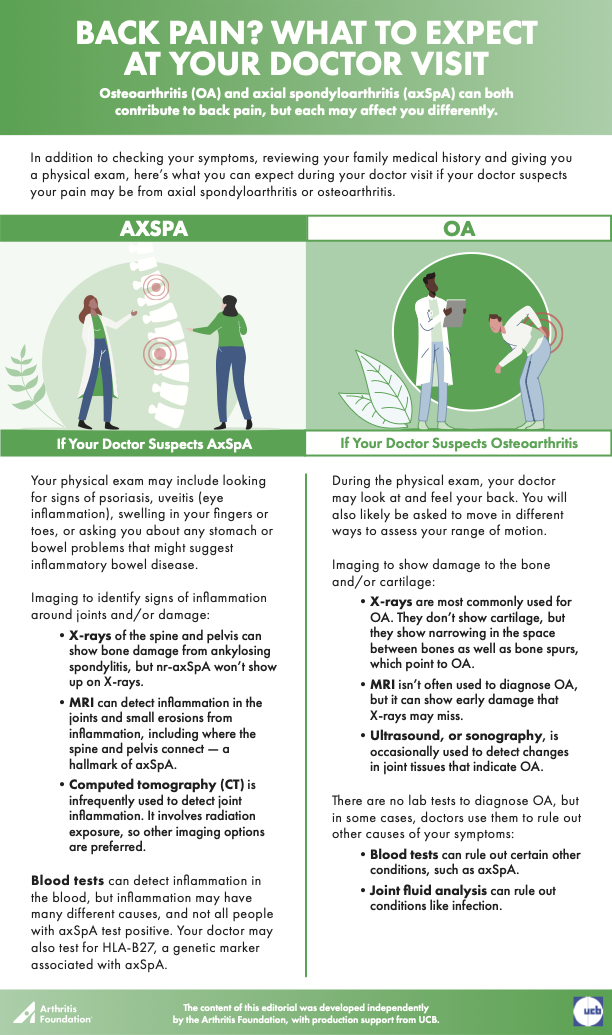Back Pain? What to Expect at Your Doctor Visit
Osteoarthritis (OA) and axial spondyloarthritis (axSpA) can both contribute to back pain, but each may affect you differently.
Sept. 14, 2022
Axial spondyloarthritis (axSpA) and osteoarthritis (OA) are both arthritis conditions that can contribute to back pain. However, they are different diseases with different treatments, so making sure you have a correct diagnosis is critical to getting relief. Learn more about the comparisons between axSpA and OA.
You will probably go to your primary care physician about the pain. Your doctor might refer you to an orthopedist, who specializes in joint health, or to a rheumatologist, who specializes in musculoskeletal diseases.
Click the image below to download the pdf file Back Pain? What to Expect at Your Doctor Visit
If Your Doctor Suspects OA
Your doctor might refer you to an orthopedist. A physical exam and your symptoms will be the main factors used to diagnose OA and determine how severe it is and how to treat it. Keep a journal of your symptoms and activities that you can show your doctor. Here’s what to expect at your appointment:
- Description of your symptoms:
- Where does it hurt?
- How long has it hurt?
- How did it start?
- What activities make it hurt more or less?
- Family medical history
- Physical exam
- Imaging to show damage to the bone and/or cartilage
- X-rays are most commonly used for OA. They don’t show cartilage, but they show narrowing in the space between bones as well as bone spurs, both of which are common in OA.
- Magnetic resonance imaging (MRI) isn’t frequently used to diagnose OA, but it can show early damage to cartilage or changes that may make a joint unstable.
There are no lab tests that can diagnose OA, but in some cases, doctors use them to rule out other causes of symptoms.
- Blood tests can rule out certain other conditions, such as axSpA.
- Joint fluid analysis can also rule out other conditions, such as infection.
If Your Doctor Suspects AxSpA
Your primary care doctor may refer you to a specialist, ideally a rheumatologist, who specializes in musculoskeletal diseases.
Like OA, axSpA cannot be diagnosed with a single test, and your symptoms are important clues to getting a correct diagnosis. Keep a journal of your symptoms and how your activities affect them to show your doctor. Unlike OA, axSpA is an autoimmune, inflammatory condition, so your doctor will likely order more testing than with OA. Here’s what to expect at your appointment:
- Description of your symptoms:
- Where does it hurt?
- How long has it hurt?
- How did it start?
- What activities make it hurt more or less?
- Do you have gastrointestinal problems that might suggest inflammatory bowel disease?
- Family medical history: Have your parents, grandparents, siblings or others had similar symptoms or an autoimmune disease?
- Physical exam, which may include looking for signs of psoriasis, uveitis (eye inflammation) or swelling in your fingers or toes. You will also be evaluated to see how well you move your back.
- Imaging
- X-rays of the spine and pelvis can show bone damage that indicates ankylosing spondylitis, but they won’t show damage from nr-axSpA.
- Magnetic resonance imaging (MRI) can detect inflammation in the joints and small erosions related to inflammation, including sacroiliitis (inflammation of the joint where the lower spine and pelvis connect), which is a hallmark of axSpA.
- Less commonly, computed tomography (CT) may be used, but it involves radiation exposure, so your doctor will probably opt for MRI first.
- Blood tests can detect inflammation in the blood using erythrocyte sedimentation rate (ESR or sed rate) and/or C-reactive protein (CRP). But if inflammation is present, it may have different causes, and not all people with axSpA have a positive test. Your doctor may also test for HLA-B27, a genetic marker associated with axSpA and related diseases. About 90% of people with ankylosing spondylitis test positive for the HLA-B27 antigen.

